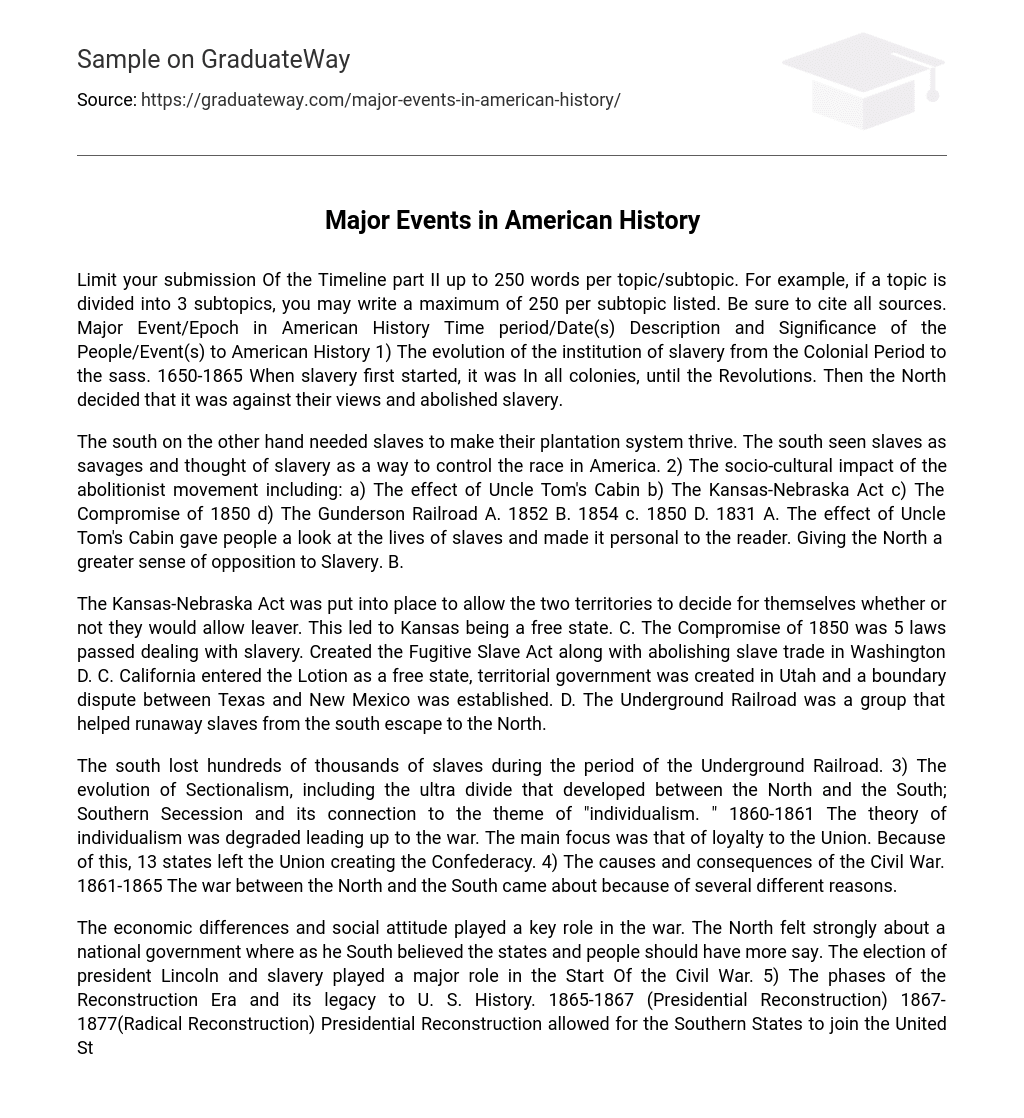To complete the Timeline part II, please keep your submission for each topic/subtopic within 250 words. For example, if a topic is divided into 3 subtopics, each subtopic should not exceed 250 words. Remember to provide citations for all sources. Below is a comprehensive overview of a major event/epoch in American History, including the time period/date(s), as well as a description and significance of the people/event(s) to American History:
1) The evolution of slavery from the Colonial Period to the sass.
Time period/Date(s): 1650-1865
Description and Significance of the People/Event(s) to American History: Initially, slavery was prevalent in all colonies until the Revolution occurred. Subsequently, the Northern states expressed vehement opposition to slavery and abolished it.
The south, on the other hand, relied on slaves to prosper in their plantation system. They viewed slaves as savages and believed that slavery was a means to control the race in America.
2) The abolitionist movement had a socio-cultural impact through various factors:
a) Uncle Tom’s Cabin played a significant role by providing readers with insight into the lives of slaves, thus making it a personal issue for them. This increased opposition to Slavery in the North.
b) The Kansas-Nebraska Act, enacted in 1854, had an impact on the movement.
c) The Compromise of 1850 is also connected to the socio-cultural impact of the abolitionist movement.
d) The Gunderson Railroad, which originated in 1831.
The Kansas-Nebraska Act granted the territories with the authority to determine the status of slavery, leading to Kansas becoming a state without slavery. The Compromise of 1850 comprised of five legislations, such as the Fugitive Slave Act and banning slave trading in Washington D.C. Moreover, it led to California joining the union as a free state, Utah establishing a territorial government, and resolving the boundary disagreement between Texas and New Mexico. The Underground Railroad served as a network that aided enslaved individuals from southern regions in their escape towards the North.
During the period of the Underground Railroad, the south lost a significant number of slaves. Sectionalism, which included a great divide between the North and the South, evolved during this time. The theme of “individualism” was closely connected to Southern Secession in 1860-1861. The degradation of the theory of individualism played a major role leading up to the war, with loyalty to the Union as the main focus. As a result, 13 states left the Union and formed the Confederacy. The Civil War took place from 1861 to 1865 and had various causes and consequences.
The Civil War was greatly impacted by economic inequalities and societal beliefs. The Northern states stressed the significance of a robust central government, whereas the Southern states advocated for more authority to be granted to individual states and citizens. The election of President Lincoln and the topic of slavery were crucial factors in instigating the war. Following this conflict, the Reconstruction Era took place in two main phases: Presidential Reconstruction and Radical Reconstruction. In Presidential Reconstruction, Southern states were allowed to rejoin the United States under their own leadership.
Freed slaves endured violence, allowing slavery to continue. The Radical Reconstruction revolutionized the South and improved treatment of freed slaves by providing political opportunities. Women also gained rights and free public education was implemented. The westward expansion post-civil War, which displaced Native American tribes, stemmed from a belief in cultural and territorial superiority since 1845.
Despite their pagan beliefs, Native Americans were not considered savages but rather an advanced society involved in trade. The relocation of these indigenous people and the blessing of the land were believed to lead to higher cotton production. The discovery of gold in California resulted in a substantial influx of immigrants to the western region of the country. From 1877 to 1900, significant socio-economic changes occurred in the United States, primarily driven by industrial growth. This era also witnessed the emergence of labor unions. Factory employment played a crucial role in the U.S. economy during this period, with workers typically working six days a week and ten hours per day.
The schedule of forced labor had an impact on various groups, including adults, children, and even pregnant women who were at risk of losing their jobs. Furthermore, workers lacked medical coverage and compensation. The conflict between the wealthy and the poor led to organized boycotts, strikes, and acts of sabotage that shut down railway stations. The significant influx of immigrants to the United States in the late 1800s and early 1900s had long-lasting effects on society, culture, and economy as it increased the pool of available laborers.
Despite their low wages, these laborers were able to improve the lives of their families. The Progressive Movement had a significant socio-cultural impact on American history during the years 1900-1918, leading to the emergence of an undesirable urban society. As a result, there was an increased responsibility towards helping the impoverished.





